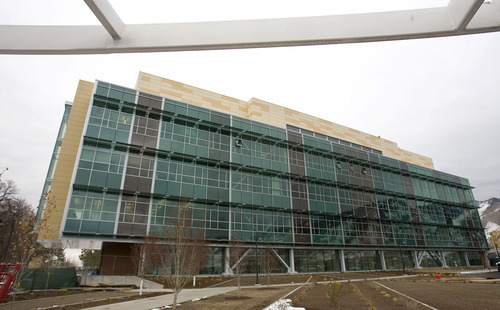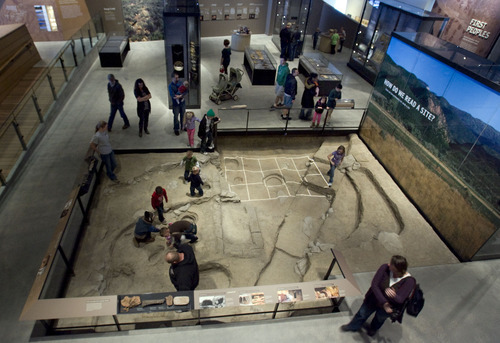This is an archived article that was published on sltrib.com in 2012, and information in the article may be outdated. It is provided only for personal research purposes and may not be reprinted.
No question, construction was hurt more by the recession than any other sector of Utah's economy. Close to 37,000 building-sector jobs vanished — almost half of all jobs lost during the downturn and much of the recovery.
But things could have been worse.
As home-building plunged, a remarkable boom in government-funded, labor-intensive construction was taking hold, and it wasn't just the headline-grabbing I-15 project in Utah County, the $350 million extension of TRAX or the National Security Agency's mega-data-center at Camp Williams.
Big as those projects were, they were only a fraction of $7 billion worth of public construction projects undertaken by local, state and federal governments (sometimes with the assistance of private donations), as well as by at least 20 school districts, during the past five years. The actual amount may be higher because no central repository exists in Utah for information about public projects, which don't need local building permits to proceed to construction.
The jobs they have provided have been a godsend. According to experts, the construction of hundreds of schools, roads and public buildings since 2005 may have supported at least 30,000 jobs — and probably more. Had those projects not come to pass, the jobless rate among construction workers in the state — it stands at 19 percent, according to the Associated General Contractors (AGC) of Utah — would be much higher. Utah's Wasatch Front-focused construction industry today might more resemble Phoenix , parts of Southern California and other devastated areas in the West.
"The [$1.2 billion] NSA project is huge. Just that alone makes this a very unique period," said Jim Wood, director of the University of Utah's Bureau of Economic and Business Research. "And then you add on the road construction in Utah County and elsewhere, which is at a very high level, and when you throw in the public buildings that have been built, you get a period where you've got more government-funded construction than at any period of time in our history."
Utah depends on construction employment. At the high point in 2007, before the recession took hold, construction jobs amounted to more than 8 percent of all jobs in the state.
On top of that, construction jobs pay comparatively well. In 2010, wages averaged $42,077 — 8 percent above the statewide level for private-sector employees, according to the AGC. As a consequence, when construction slows, the rest of the economy can suffer. At the moment, construction employment is down to 5 percent of all Utah jobs. The loss means that $1.5 billion in annual wages aren't being pumped into Utah's economy.
Most of the job losses occurred in residential construction. Permits for new single-family houses plunged 86 percent in Utah from their high in 2005 to their low in early 2009. Permits were still down 74 percent at the end of last year, according to the Federal Reserve Bank of St. Louis.
But even as the recession ripped through the home-building industry, a lot of non-residential construction was going on, most notably the massive $1.2 billion City Creek project in downtown Salt Lake City.
City Creek, with multiple high-reaching cranes filling the skyline, caught the attention of the public. What was not as visible was government-funded construction, particularly at Utah's public colleges and universities.
At the University of Utah, for example, building projects totaling almost $700 million either were completed recently, are under construction or are being designed, according to the state Division of Facilities and Construction Management. That's almost as much as the division was managing for all state agencies and universities in 2005.
When Lynn Hinrichs started managing the division's construction work that year, the volume of projects stood at around $800 million. Today, Hinrichs is in charge of projects with construction values that add up to $1.6 billion. The projects are keeping thousands of workers off the unemployment rolls.
"We estimate that approximately 7,500 full-time-equivalent jobs are active as a result of this work," Hinrichs said.
Federal stimulus dollars explain only some of the activity. Some of the lowest interest rates in modern times, coupled with falling prices for building materials, were important, too. Construction costs have declined 20 percent since the onset of the recession in late 2007, said Rob Moore, president of Big-D Construction, which built the $75 million Natural History Museum of Utah (that opened in November) and is constructing the $40 million Center for New Media at Salt Lake Community College. Big-D is also one of three lead contractors on the $1.2 billion Utah Data Center.
Over the course of the recession and recovery, Big-D's payroll has bounced from 600 down to 400 and now stands at 800 as the company moves forward on the Data Center, a science building at Utah Valley University and a classroom building at Weber State University.
"We've had some pretty significant contracts," Moore said. "I think it's just a good time for public entities to buy construction projects and to replenish infrastructure."
Another big Salt Lake City company, Jacobsen Construction, retained its workforce during the downturn, thanks to projects such as the $52 million L.S. Skaggs Pharmacy Building at the U., the Medical Intensive Care Unit at the University of Utah Hospital, and Utah State's $40 million College of Agriculture building. Jacobsen's payroll will expand from about 425 workers to about 700 by late spring as the company gears up for another hospital project at the U, said Jack Wixom, vice president of corporate relations.
"We have been very fortunate to have some very large and important projects during that time when the industry was stressed," Wixom said. "They have been able to keep our people employed and excitedly engaged. When there is a downturn in the economy, to have a job and to be doing that job for the benefit of society, it's a very important thing."
The pace of public construction has probably peaked, said Wood, the U's economic research bureau director. Most of the state's construction funds come from issuing bonds. Under Utah's Constitution, the state's bonding limit is 1.5 percent of the total fair market value of all taxable property. As of June 30, when the state's 2011 fiscal year ended, Utah's unused bonding capacity was down to $525 million. Three years earlier, the unused capacity was $3.2 billion. The decline occurred because Utah sold billions of dollars of bonds to pay for building projects and because taxable property values declined.
"Those two kind of converged and did away with some of the headroom we had to bond" for more projects, Wood said.
Still, the future doesn't look bleak. A survey by AGC of construction companies in Utah found that the dollar value of public projects they can bid on in 2012 shows virtually no erosion over last year. AGC found that 86 percent of the surveyed companies believe highway funds will be the same as 2011, while 87 percent think hospital and higher education dollars will be the same or higher.
Fifty-six percent of the companies think dollars for public buildings will be the same or higher this year, while 62 percent think the same about elementary and secondary school projects.
"The last couple of years we've been at an all-time high for building projects and highway construction. We've probably got another 18 months to two years of these big projects. Now, will there be others that come on? There will be probably some, but not at the same level," Wood said.
pbeebe@sltrib.com Twitter: @saltlakepaul







